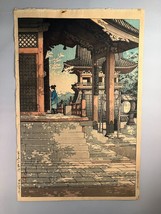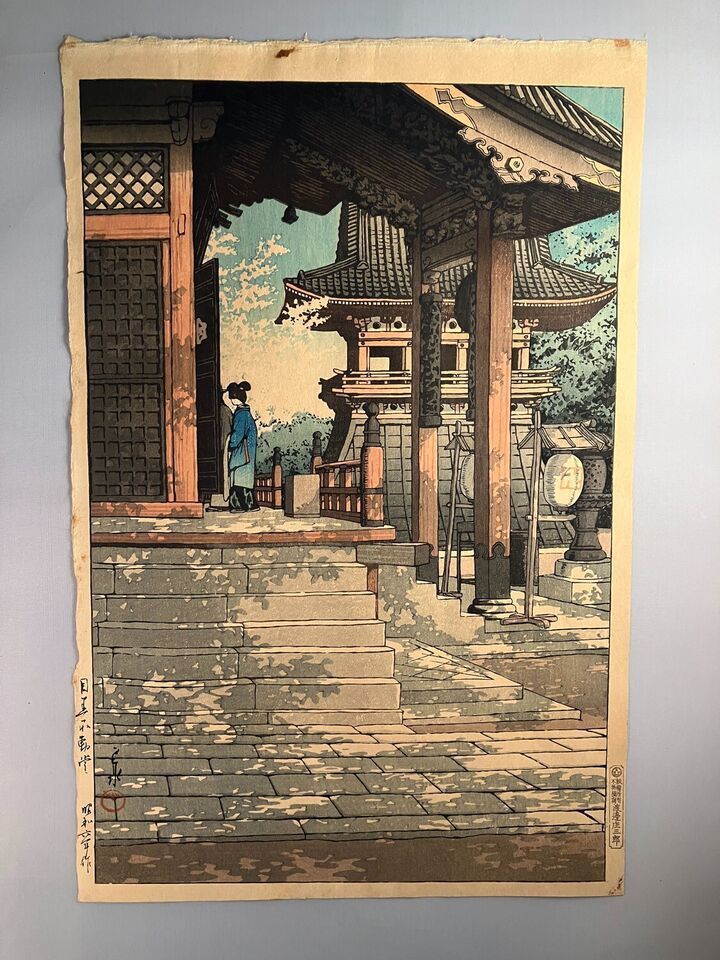Vintage Kawase Hasui ‘Fudo Temple in Meguro’ and similar items
Envío gratis
Vintage Kawase Hasui ‘Fudo Temple in Meguro’ 1931 Color Woodblock Print Oban
$229,907.64 MXN
(It may be possible to pay only $12,485.00 instead of $12,500.00 when you
use your bCredits at checkout)
Sign up and get $15.00 bCredits free to use at checkout and another $5.00 bCredits when you make your first purchase. More info
Share & earn! Sign in, share this or any listing, and you’ll get commission when it sells.
Learn more
View full item details »
Las opciones de envío
Política de oferta
OBO - El vendedor acepta ofertas en este artículo.
Detalles
La política de devoluciones
Partial refund available within 30 days
Protección de compra
Opciones de pago
PayPal accepted
PayPal Credit accepted
Venmo accepted
PayPal, MasterCard, Visa, Discover, and American Express accepted
Maestro accepted
Amazon Pay accepted
Nuvei accepted
View full item details »
Las opciones de envío
Política de oferta
OBO - El vendedor acepta ofertas en este artículo.
Detalles
La política de devoluciones
Partial refund available within 30 days
Protección de compra
Opciones de pago
PayPal accepted
PayPal Credit accepted
Venmo accepted
PayPal, MasterCard, Visa, Discover, and American Express accepted
Maestro accepted
Amazon Pay accepted
Nuvei accepted
Rasgos del artículo
| Categoría: | |
|---|---|
| cantidad disponible: |
Sólo uno en stock, para muy pronto |
| Condition: |
Unspecified by seller, may be new. |
| Region of Origin: |
Japan |
| Primary Material: |
Paper |
| Original/Reproduction: |
Vintage Original |
| Maker: |
Kawase Hasui |
| Seller Notes: | |
| Featured Refinements: |
Japanese Woodblock Print |
| Age: |
1931 |
Detalles del anuncio
| Las políticas del vendedor: | |
|---|---|
| Envío de descuento: |
Vendedor paga el envío para este artículo. |
| Publicado en venta: |
Más de una semana |
| Artículo número: |
1751666041 |
Descripción del Artículo
Vintage Kawase Hasui (1883-1957, Japanese) ?Fudo Temple in Meguro?
1931 Color Woodblock Print - Oban
Title: Fudo
Temple in Meguro (Megaro Fudo Do)
Edition: Life
Time Edition
Date: 1st
Publication 1931 ? Watanabe D Seal
Series: One
hundred views of new Tokyo (Shin Tokyo Hyakkei)
Seal: Kawase
Signature: Hasui
Publisher: Watanabe
Shozaburo
Size: 15.25
x 10in (38.75 x 25.5cm) Vertical Oban
Impression: Very
good impression and color. Some toning.
Condition: Excellent;
only slight toning. Strong colors; clean backside.
Reference: Hotei
#341, Narazaki #322
Comments: Narazaki
reports that this composition was designed with an interest in depicting the
complex shadows which are seen cast on the flagstones of the temple's path and
steps. The "backwards swastika" symbol is actually the Japanese kanji
for "temple."
Hasui was born in Tokyo and studied both Japanese and
European painting techniques as a child. His interest in Japanese woodblock
prints developed during his apprenticeship at the age of 27 with the famous
Japanese painter, Kaburaki Kiyokata, and his friendship with another
apprentice, Ito Shinsui.
Regarded as a major Japanese artist, Hasui Kawase?s prints
are characterized by their serenity of mood and flawless composition. Born
Bunjiro Kawase in Tokyo, Hasui Kawase was the son of a silk braid merchant. He
began his artistic career studying Japanese-style painting with Kiyokata, as
well as Western-style at the Hakubakai. His talent was clear, exhibiting in the
Tatsumi Exhibition of Painting at age 19. However, soon after seeing Shinsui?s
series Eight Views of Lake Biwa, Hasui turned his attention to woodblock
printing in 1919. Shozaburo Watanabe was the first to recognize his artistic
genius and Hasui Kawase soon became the most popular artist working for this prestigious
publisher. Hasui traveled widely in Japan and his subjects consisted mostly of
his surroundings.
Unfortunately, during the earthquake of 1923, all of his
woodblocks and over 200 sketches were destroyed. The works that predate this
event are extremely scarce and in great demand today. Undaunted, Hasui
continued to produce his prints. In 1956, the Japanese government?s Committee
for the Preservation of Intangible Cultural Heritage designated Hasui's Zojo
Temple in Snow and the documentation of its production as Intangible Cultural
Treasures, the greatest artistic honor in postwar Japan. All of his woodblock
prints are signed ?Hasui? usually with a variety of red seals reading ?sui.?
Kawase Hasui is one the great masters of the Shin Hanga
movement. Shortly before his death, the Japanese government declared his art
work a Living National Treasure, the highest honor bestowed in modern-day
Japan.
BTC ETH XRP XLM DOGE LTC
Loading
Este artículo ha sido añadido a su carrito
 Vintage Kawase Hasui ‘Fudo Temple in Meguro’ 1931 Color Woodblock Print Oban added to cart.
Único disponible en stock
Vintage Kawase Hasui ‘Fudo Temple in Meguro’ 1931 Color Woodblock Print Oban added to cart.
Único disponible en stock
Ver el carro o seguir comprando.
 Por favor, espere mientras termine de agregar este artículo a su carrito.
Por favor, espere mientras termine de agregar este artículo a su carrito.
Get an item reminder
We'll email you a link to your item now and follow up with a single reminder (if you'd like one). That's it! No spam, no hassle.
Already have an account?
Log in and add this item to your wish list.

















